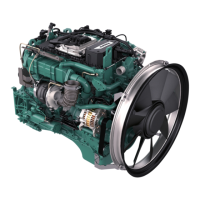Do you have a question about the Volvo Penta TAD734GE and is the answer not in the manual?
Powerful, reliable, economical, durable, low noise, low emission, and easy-to-service in-line six diesel engine.
Covers engine block, lubrication, fuel, intake/exhaust, cooling, and electrical systems.
Highlights EMS 2, electronic governing, CAN bus, and noise optimization for efficient operation.
Engine designation, bore, stroke, displacement, compression ratio, and weight details.
Power output, fuel consumption rates, and emission compliance at various speeds.
Details the standard components and features included with the engine package.
Explains the EMS 2 system, input/output signals, and fuel control for precise engine operation.
Describes the diagnostic function for detecting, locating, and reporting engine malfunctions.
Details the DCU instrument panel, its functions, menus, and button operations for monitoring.
Provides step-by-step instructions for starting the engine using the DCU panel.
Essential checks including oil level, fuel valves, coolant, and general visual inspection.
Guidance on starting in cold weather and using auxiliary batteries safely.
Table of common symptoms, their possible causes, and corresponding page references for solutions.
Explains the diagnostic function's role in monitoring, detecting, and guiding fault tracing.
Outlines recommended maintenance intervals based on hours or calendar time for various service types.
Introduces maintenance items and notes that unlisted points require authorized workshops.
Emphasizes visual inspection of the engine for leaks, loose parts, and belt condition.
Details checking the air filter and the procedure for replacing it when indicated.
Diagram showing the location of various engine sensors on the TAD940-943GE/VE and TAD950-952VE models.
Instructions on how to check and maintain the engine oil level, including dipstick reading and oil type.
Step-by-step guide for changing engine oil and oil filters, with safety precautions.
Procedure for changing the fuel pre-filter, including draining and lubrication steps.
Instructions on how to vent the fuel system after filter replacement or fuel supply interruption.
Guidance on checking coolant levels, topping up, and filling a completely empty system.
Procedures for cleaning the cooling system, including flushing and using cleaning solutions.
Information on the main switch operation and the function of the 10A circuit breaker fuse.
Details on battery connection, cleaning, filling, charging, and safety precautions.
Checklist for laying up the engine for periods of two months or more to prevent damage.
Steps to take to prepare the engine for use after a period of storage.
Comparative data for TAD940GE, TAD941GE, TAD940VE, TAD941VE, TAD942VE, TAD943 models.
Comparative data for TAD950VE, TAD951VE, TAD952VE models.
Oil capacity, pressure, filter types, oil recommendations based on sulfur content, and viscosity charts.
Feed pump pressures, bypass valve opening pressure, fuel standards, and biodiesel compatibility.
Pressure cap, coolant quantities, thermostat specifications, and coolant types.
Lists ASTM D4985 water quality parameters for coolant mixing.
Details on system voltage, alternator ratings, battery capacity, and electrolyte specific gravity.
Explains how to locate and interpret chassis ID, serial numbers, engine designation, and software versions.
Powerful, reliable, economical, durable, low noise, low emission, and easy-to-service in-line six diesel engine.
Covers engine block, lubrication, fuel, intake/exhaust, cooling, and electrical systems.
Highlights EMS 2, electronic governing, CAN bus, and noise optimization for efficient operation.
Engine designation, bore, stroke, displacement, compression ratio, and weight details.
Power output, fuel consumption rates, and emission compliance at various speeds.
Details the standard components and features included with the engine package.
Explains the EMS 2 system, input/output signals, and fuel control for precise engine operation.
Describes the diagnostic function for detecting, locating, and reporting engine malfunctions.
Details the DCU instrument panel, its functions, menus, and button operations for monitoring.
Provides step-by-step instructions for starting the engine using the DCU panel.
Essential checks including oil level, fuel valves, coolant, and general visual inspection.
Guidance on starting in cold weather and using auxiliary batteries safely.
Table of common symptoms, their possible causes, and corresponding page references for solutions.
Explains the diagnostic function's role in monitoring, detecting, and guiding fault tracing.
Outlines recommended maintenance intervals based on hours or calendar time for various service types.
Introduces maintenance items and notes that unlisted points require authorized workshops.
Emphasizes visual inspection of the engine for leaks, loose parts, and belt condition.
Details checking the air filter and the procedure for replacing it when indicated.
Diagram showing the location of various engine sensors on the TAD940-943GE/VE and TAD950-952VE models.
Instructions on how to check and maintain the engine oil level, including dipstick reading and oil type.
Step-by-step guide for changing engine oil and oil filters, with safety precautions.
Procedure for changing the fuel pre-filter, including draining and lubrication steps.
Instructions on how to vent the fuel system after filter replacement or fuel supply interruption.
Guidance on checking coolant levels, topping up, and filling a completely empty system.
Procedures for cleaning the cooling system, including flushing and using cleaning solutions.
Information on the main switch operation and the function of the 10A circuit breaker fuse.
Details on battery connection, cleaning, filling, charging, and safety precautions.
Checklist for laying up the engine for periods of two months or more to prevent damage.
Steps to take to prepare the engine for use after a period of storage.
Comparative data for TAD940GE, TAD941GE, TAD940VE, TAD941VE, TAD942VE, TAD943 models.
Comparative data for TAD950VE, TAD951VE, TAD952VE models.
Oil capacity, pressure, filter types, oil recommendations based on sulfur content, and viscosity charts.
Feed pump pressures, bypass valve opening pressure, fuel standards, and biodiesel compatibility.
Pressure cap, coolant quantities, thermostat specifications, and coolant types.
Lists ASTM D4985 water quality parameters for coolant mixing.
Details on system voltage, alternator ratings, battery capacity, and electrolyte specific gravity.
Explains how to locate and interpret chassis ID, serial numbers, engine designation, and software versions.
| Engine Model | TAD734GE |
|---|---|
| Engine Type | Diesel |
| Number of Cylinders | 6 |
| Fuel System | Common Rail |
| Cooling System | Water-cooled |
| Configuration | In-line |
| Displacement | 7.15 L |
| Bore | 108 mm |
| Power Output | 162 kW |
| Aspiration | Turbocharged |
| Emissions | EU Stage II |












